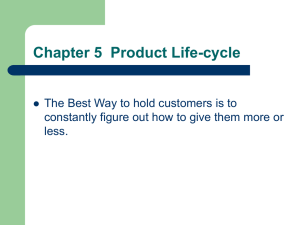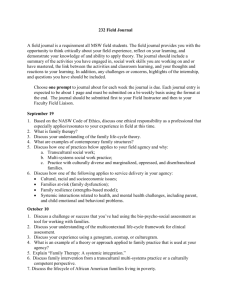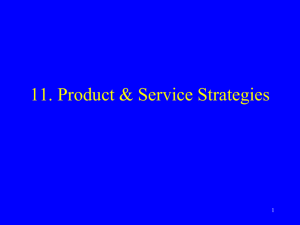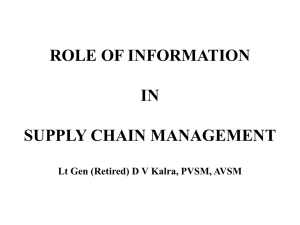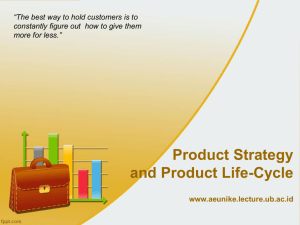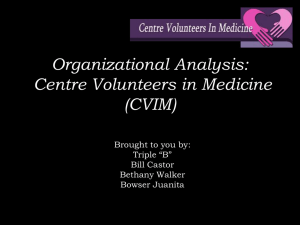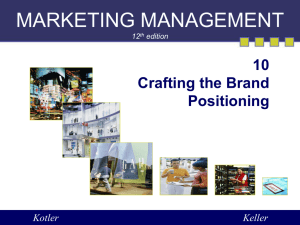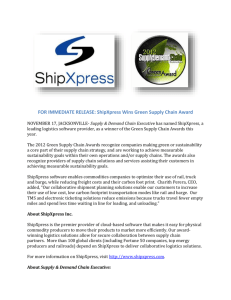LIFE-CYCLE THINKING IN THE
advertisement
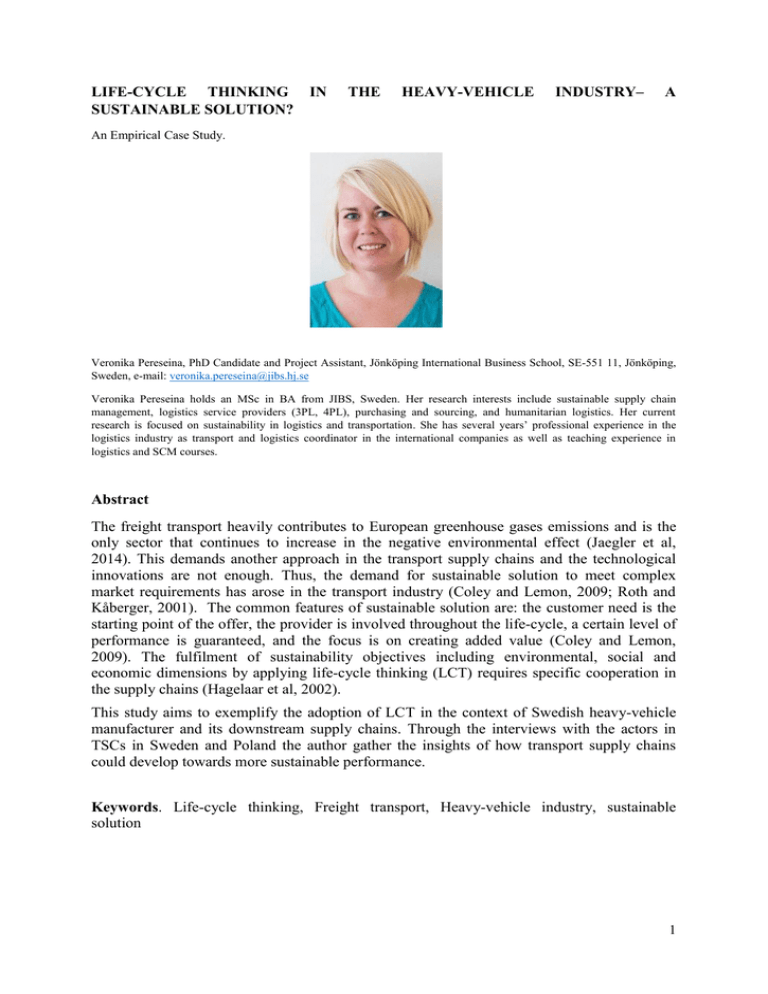
LIFE-CYCLE THINKING SUSTAINABLE SOLUTION? IN THE HEAVY-VEHICLE INDUSTRY– A An Empirical Case Study. Veronika Pereseina, PhD Candidate and Project Assistant, Jönköping International Business School, SE-551 11, Jönköping, Sweden, e-mail: veronika.pereseina@jibs.hj.se Veronika Pereseina holds an MSc in BA from JIBS, Sweden. Her research interests include sustainable supply chain management, logistics service providers (3PL, 4PL), purchasing and sourcing, and humanitarian logistics. Her current research is focused on sustainability in logistics and transportation. She has several years’ professional experience in the logistics industry as transport and logistics coordinator in the international companies as well as teaching experience in logistics and SCM courses. Abstract The freight transport heavily contributes to European greenhouse gases emissions and is the only sector that continues to increase in the negative environmental effect (Jaegler et al, 2014). This demands another approach in the transport supply chains and the technological innovations are not enough. Thus, the demand for sustainable solution to meet complex market requirements has arose in the transport industry (Coley and Lemon, 2009; Roth and Kåberger, 2001). The common features of sustainable solution are: the customer need is the starting point of the offer, the provider is involved throughout the life-cycle, a certain level of performance is guaranteed, and the focus is on creating added value (Coley and Lemon, 2009). The fulfilment of sustainability objectives including environmental, social and economic dimensions by applying life-cycle thinking (LCT) requires specific cooperation in the supply chains (Hagelaar et al, 2002). This study aims to exemplify the adoption of LCT in the context of Swedish heavy-vehicle manufacturer and its downstream supply chains. Through the interviews with the actors in TSCs in Sweden and Poland the author gather the insights of how transport supply chains could develop towards more sustainable performance. Keywords. Life-cycle thinking, Freight transport, Heavy-vehicle industry, sustainable solution 1 LIFE-CYCLE THINKING SUSTAINABLE SOLUTION? IN THE HEAVY-VEHICLE INDUSTRY– A 1. Introduction There is a world-wide consensus that decreasing environmental influence of the society is the global challenge. Since 1997 Kyoto Protocol targets reduction of greenhouse gas emissions in the industrialized countries (Rothegatter, 2010). Transport sector clearly represents one of the biggest sectors of negative environmental influence which, opposed to other industries, continues to increase (Aronson and Brodin, 2006; Hill, 2012; Jaegler, 2014). This fact requires the changes in the transport sector along the whole supply chain, assessing long-term sustainability criteria (Roth and Kåberger, 2001). The demand for innovative solutions to meet complex market requirements including sustainability goals has arose in the transport industry (Coley and Lemon, 2009; Roth and Kåberger, 2001). The design of more sustainable solutions is not highly researched and applied but according to Van der Zwan and Bhamra (2003) the common features of sustainable solution are: the customer need is the starting point of the offer, the provider is involved throughout the life-cycle, a certain level of performance is guaranteed, the focus is on creating added value (Coley and Lemon, 2009). Life cycle thinking includes the concept of life-cycle assessment and life-cycle costing while LCA is the approach connected to the environmental, social and economic dimensions in supply chain management (Kwan and Kim, 2013; Matos and Hall, 2007). The fulfilment of sustainability objective by applying LCA requires specific cooperation in the supply chains (Hagelaar et al, 2002). There is a number of the studies that has been performed in the transport and heavy-vehicle industries however not many on a supply chain level with the manufacturer embedding sustainability on a strategic level. The application of the life-cycle thinking in the longhaulage transport sector and its influence on sustainable performance of the sector is the theoretical and practical gap the author is aiming to address in this study with the help of empirical investigation. In this study the focus of analysis is the life-cycle thinking The influence on sustainability is mainly seen through cost (economic), CO2 emissions (environment) and safety (social) issues and thus in this study they characterise sustainability concerns. The purpose of this study is to understand if life-cycle thinking can be used as a sustainable solution in the heavy-vehicle and transportation industry. The paper starts with the short theoretical literature overview. The methods of the study are discussed next. The empirical results are presented in the third part. The paper concludes with the analysis and future implications. 2 2. Theoretical overview 2.1 Sustainability in transportation Transportation is growing worldwide with high growth rates due to many reasons: world-wide distribution of workflows, reduction of transport cost and time, growth of income, economic development. The road transport (out of all transport modes) is the major source of the production of the CO2 emissions and the negative effect of the industry continues to increase (Rothengatter, 2010; Hill, 2012). Thus, one of the logistics goals should be decreasing the environmental impact of transport and this demands another approach in the transport networks (Aronsson and Brodin 2006). The reduction of environmental impacts can be influenced by two general approaches: firstly, while relying on new, energy efficient technology; secondly, relying on companies to restructure their processes in a more sustainable way (Aronsson and Brodin 2006). Thus, this can bring challenges to the companies to adopt the changes and integrate and implement sustainability into the supply chain management (Morali and Cearcy, 2013). Purchasing and distribution have a vital role in improving sustainability of firms; therefore there is a need for awareness of strategic and tactical decisions’ influence on operational outcomes in order to make more sustainable decisions. Strategic decisions have a larger effect on aspects such as emissions than operative decisions (Aronsson and Brodin 2006). The way forward for sustainable logistics is hence through innovations via new transport technologies and intermodal systems as well as better utilisation and life-cycle thinking. Being a potential source of competitive advantage, sustainability goals require closer interaction between all supply chain actors while ensuring economic, environmental and social performance with more performance criteria to be met (Tavasszy et al, 2003; Linton et al, 2007) 2.2 Life-cycle thinking There is a growing discussion on the strategy of more efficient transportation and sophisticated logistics processes also through life-cycle thinking though not to a great extent in supply chain management field (Tavasszy et al, 2003). Life-cycle thinking includes the perspectives of both life-cycle costing and life-cycle assessment. Life-cycle costing refer to the costs associated with the product’s lifetime and life-cycle assessment considers the manufacturing (or purchase), usage, maintenance, and end-of-life treatment of the product (Kwan and Kim, 2013). Even though a focus on supply chain initially is a step forward to development of sustainability due to the fact that the supply chain considers life-cycle of the product (most usage of the product), some other issues should be integrated beyond the core of supply chain management and product life extension is one of them (Linton et al, 2007). The authors state that techniques such as life cycle assessment can be used for assisting in the determination of product design and minimization of its environmental impact over its useable life and after it. Resources reduction and environmental impacts are considered in the interface of engineering and product design through cleaner process technologies and quality production techniques. This approach increases the value produced by an individual product. The challenge for the provider of the product is to develop offerings that allow for them to capture more of the product value. The strategy for sustainable solutions as the definition of life-cycle based 3 standards for the environmental and social performance of products implemented throughout the supply chain is discussed by a number of authors (Kleindofer et al, 2005, Linton et al, 2007, Aronson and Brodin, 2006; Kwak and Kim, 2013). The perspective of life-cycle assessment can be covered through improved vehicle utilization as one of the objectives for sustainable logistics. Three main objectives of sustainable transportation are: contributing to road shift through switching to other modes, reducing the demand for transport and changing logistics structures and reducing environmental impact of the transportation through improved vehicle utilization. The sustainable logistics structure can be characterized by fewer movements, less handling, shorter transportation distances, more direct shipping routes and better utilisation (Hill, 2012; Aronson and Brodin, 2006). The recent trends within transportation sector may also influence the increased capacity utilisation of the transportation means (van Hoek and Johnson, 2011). The influence of transportation on the environment can come from three main sources and one of them is operation of transport vehicles (two others include transport networks and disposal of vehicles). While talking about transport efficiency, the increasing employment of the transport vehicle allows for keeping fleets more energy efficient and less polluting. The integrated solution here can represent the sustainable system of products and services addressing the customer needs and sustainability issues and even more, being both profitable for companies and beneficial for society. While designing more sustainable solution, there are several commonalities identified: the customer need is the starting point of the offer, the provider is involved throughout the life-cycle of the product and guarantee a certain level of performance; there is a focus on creating added value. The maintenance of vehicles is also a major environmental problem thus proper maintenance programmes help maintain vehicles in safe and efficient working conditions (Wu and Dunn, 1995; Coley and Lemon, 2009). In the context of supply chains, supply chains should be clearly extended to deliberate the total life-cycle of the product, and to optimize the product not only from existing cost standpoint but also a total cost standpoint. Total cost should include the influence of resource reduction and the generation of by-products that are neither captured nor used (waste and pollutants). Thus, the considerations of sustainability issues could be performed through the advanced solution oriented partnership where sustainable system of products and services is delivered in a highly effective way by supply chain while minimising economic and environmental costs (Linton et al, 2007; Coley and Lemon, 2003). Analysis of the operational implications of different policies and integration of sustainability in business is critical, since current legal tendencies will influence many of these changes ‘whether or not academe and practice is prepared’ (Linton et al, 2007:1080). 3. Methods The current paper is based within the project with the Swedish heavy-vehicle manufacturer and its downstream supply chains in four different countries, two of which are included in this paper. The primary data collection is made through the number of data collection tools. First, the major base for the study is the conducted interviews with The Manufacturer and its downstream supply chain (Dealers and Customers) in Sweden and Poland. The major part of the interviews was done in 2012-2013 (see table 2). All the interviews were recorded and transcribed verbatim. The first step of data collection included interviewing the case company for the concepts and context understanding. There were 39 interviews in total (table 1). 4 Table 1 - The interviews NR of interviews/ Country Sweden Poland Company’s representatives 15 10 Dealers (sales representatives) 4 2 Transport companies (customers) 2 6 Total 21 18 The semi-structured questions were used in the interviews (Eisenhardt, 1989) which referred to diverse aspects of the company’s business. The secondary data collection was based on the secondary material collected from the case company head office, the dealers and customers. The secondary material includes information from the meeting protocols, company reports and regulatory reports, as well as external and internal promotional material of the actors in the supply chain. By coding the interviews’ transcripts (Ellram, 1996; Myers 2009,), the empirical material was subsequently reviewed for indications regarding the issues questioned in the article. For the analysis of the data the author used the general analysis pattern-matching analytic technique (one of the five analytical techniques by Yin, 2009. Such logic helps to compare the empirically based pattern (grounded in the findings from the case study) with predictions made before collecting the data. The quality of the study. The study employs multiply sources of evidence including the interviews, meetings and secondary data which allows addressing broader range of issues and covers the triangulation of data in the study. The chain of evidence is maintained in the following way: RQs – case study protocol (interview protocol) – case study database. The case study data base was created for this study (reliability). The common database (Dropbox) with structurally arranged data was used. For each country the interviews data was organized according to the respondents: with company’s representatives, dealers, customers, other stakeholders. The transcriptions were organized in this logic as well. The secondary data are also organized accordingly. All the raw data (notes, documents, tables, brochures) was saved separately from researcher’s reports which increase the construct validity of the study. 4. Empirical data The main researched entity of this study is a European manufacturer of heavy-vehicles (The Manufacturer), its supply chains and one of its offered solutions - Ecolution. The Manufacturer is focused on high-end heavy-vehicles and extended service offerings and is operating in the heavy-vehicle industry worldwide. The Ecolution is however not offered in all markets. Sweden and Poland are within the countries where the concept has been introduced. Interviewed actors in the supply chain are dealers and customers of The Manufacturer and other member of logistics industry in Sweden and Poland. The Manufacturer’s offering Ecolution is applied in many markets, including Sweden and Poland. With it, the customers and The Manufacturer co-evolve. The relationship is seen as a strategic partnership. The sales process focuses not only on a product, but also on added services for the transportation task, letting the customer take care of its business and The Manufacturer takes care of all activities connected to the products. The Manufacturer’s 5 offered solution includes four pieces: the vehicle, which is specified according to the customer operations; maintenance - inspection points: checking tire pressure, lowest possible fuel consumption; driver training - checking the driver performance once per month for keeping the level achieved in the beginning; coaching of the drivers - in order to keep the results of the training ongoing. Ecolution is the concept which includes the best products and services from the Manufacturer in the overall solution aiming to decrease fuel consumption and carbon emissions. The concept also includes developing an individualized customer’s goal achievement that The Manufacturer is helping to achieve. In order to reach this goal, the company is using different modules of Ecolution. The content of each module is customized to specific business but the main facets of the Ecolution are always the same: vehicles - optimized specification, driver training, driver monitoring and maintenance. Director Strategic Planning, Sales and Service Management points that the good thing with Ecolution is: lower fuel consumption equals lower CO2 emissions and lower cost. Since fuel is usually 1/3 of the total cost, the decrease in the fuel consumption brings a substantive decrease in the costs (economic benefits). Also, drivers’ training helps for reducing accidents with heavy vehicles involved (which is good for society). For the company, trained drivers mean less fuel consumption, which means more profit. For The Manufacturer it means less repairs and less service (since the vehicle is driven in a better way). The customer, The Manufacturer and society benefit while being more sustainable. POLAND on Ecolution: The Manufacturer and sales representatives: Our customers are looking for fuel savings and this is something which they can really save in their normal operation. With driver training there is in average 10% reduction of the fuel on each truck, which is (considering the mileage) a really big saving. Though, no promises can be made, due to the fact that The Manufacturer cannot fully control the process of their customers (drivers, air deflectors positioning, air pressure in tires) – it all depends on the common activities, The Manufacturer and the customer, doing it together, can keep the level of fuel savings. There were few factors which influenced the Ecolution sales: first of all, our customers are looking for fuel savings and this is something which they can really do with it in their normal operation. Second, the driver training is perceived very well in the market. We started with this concept 7 year ago and then year by year, we are training more than 1000-1200 drivers per year. And it is really showing that after such training an average of 10% reduction of the fuel on each truck can be made. The coaching of the drivers helps the drivers not to come back to the previous behaviour before the training, and its working. The sales of Ecolution is a very interactive process, there is a big interest from the customer and thus from the sales force, we were actually surprised how well the customers received the concept. Ecolution sales demands 100 questions and answers from customer in order to develop the solution so it makes the process very interactive. During coaching 3 guys are talking to customers all the time. Customers: 6 Ecolution package makes it easier to control both driver and truck. We are deciding to buy a new truck next month, use Ecolution package. Ecolution is better because of lower fuel consumption. The drivers really enjoy the trucks as well. The Ecolution truck(s) are well equipped and has black frame in front. The reduction in fuel usage is most important. Ecolution should be for sold only for special customers (such as us) as a bonus since it actually increases the profitability through a lower cost of fuel. Ecolution reduces fuel consumption with 3 litres per 100 km, you can save 300 000 – 400 000 liter/year through Ecolution which can save us about 1.5% in costs. Service network is of high importance when there is a breakdown. Sweden on ECOLUTION: The Manufacturer’s and sales representatives: The sustainability concerns are in the service package that we offer through Ecolution. The training of the drivers is not only helping to decrease the fuel consumption but also provide the ergonomic benefits to the driver on how to maintain the body and soul. It is quite interesting with Ecolution as it considers environment and safety. I believe that it is a help to change the situation with the drivers through giving the better working environment for them and in this way they can probably perform better. The situation is not too good with the drivers in many places around the world. In order to improve this, the companies should understand that providing better conditions for drivers may not only benefit the drivers but also through drivers’ training there is a possibility to decrease the fuel cost. With Ecolution we score high in terms of sustainability issues. That is always gratifying, and we work very hard on these issues. Ecolution is a collective label for a number of services that we have developed: services that have been developed to keep vehicles genuinely updated in terms of technology so they can meet their environmental standards. We have also found that driver training is extremely important for fuel consumption. This is because there is a 1520 percent difference in fuel consumption between a good driver and a bad one. If you have 100,000 litres of fuel consumption per year, 20 percent is close to 20,000 litres. In other words, we are talking about very large figures. The solutions do not always generate higher revenue. In the good examples the life cycle revenue never ends, because the customer involves The Manufacturer in its business. The bad examples are the deals when calculations were made wrong. There is a need to educate sales and service people since sometimes the customers are more in contact with service than sales representatives. The customers do not really know about the environmental issues, but their customers have demands and are very much into environmental issues. Therefore, if you take Ecolution , it is a success , it takes time, it is along the fuel price, but it is not primarily CO2 reduction that drives it. You need to show reduction of cost, it is everywhere in the world. More noticeable change must be done (e.g. regulations). We had customers who used Ecolution and said it was great for them. I have not met skepticism towards it out in the market and it is fact, you save money with this solution, you do, its pure fact. 7 Ecolution concept is based on the customers profit from it and the long-term relationships. It is not difficult to convince customers. It's not a question of how much it costs, but how much they earn on it. We have implemented the concept with quite a few of our Customers Sweden. The customers care about environmental concerns. And usually it is the customers' customers who are demanding in these regards. There is a part of haulers who work very seriously with this. E.g. I was just talking to the trucking company, which wants to be carbon-free by 2020 on all their vehicles. Customers: There is a concern about the environment from our customers, on the personal level I consider this to, but I should also think about my business. Ecolution is providing the solution for both concerns. 5. Analysis and Conclusions Sustainable aspects which are included in the life-cycle solution of The Manufacturer are affecting the whole downstream supply chain with the continuous demands for decreased fuel consumption and improved vehicles’ efficiency as well as sustainable performance of the actors involved with the help of all four facets of the solution. The high-end vehicle with the recent technological improvements allows for the major environmental and social considerations. The driver training adds to the increase of drivers’ safety and improved working environment. It also affects the society in general since the trained drivers cause fewer traffic accidents on the roads. Driver training and driver coaching result in lower fuel consumption and since fuel is 1/3 of the lifetime cost for the transport companies, it brings noticeable economic benefit to a company. The decrease in fuel consumption equals lower CO2 emissions. In this way the environmental considerations of the customer and customers’ customer are considered. The life-cycle solution for The Manufacturer in this case means fewer repairs and also fewer services (since the vehicle is driven in a more efficient way). The relationship is strategic and long-term and involves The Manufacturer throughout the customers’ business. The complex solution considers the customers’ specifications and adopted set of services creates the added-value for the customer. The product life extension and calculation of life-time costs are other facets of sustainable solution, thus in the case of Ecolution the costs are calculated based on the total use of vehicles. The utilisation of the vehicles is increased due to the more efficient employment of the vehicles. As one of the further ways to more sustainable business - life-cycle thinking allows the companies to deal with the trade-off between economic, social and environmental requirements in an efficient way. This can create benefits for diverse stakeholders in the supply chain in terms of reduced environmental impact and improved traffic safety as this empirical example shows. Together with other strategies for sustainable transportation (new technologies, decrease for demand of transportation, multimodal transportation) the life-cycle thinking can help achieve sustainability goals of the industry. 8 The managerial implications. The managers of the transport companies can use the results of this study to consider the application of the life-cycle thinking in the business with their customers. Implications for future research. The concept is based on the life-cycle thinking, including the life-cycle costing and life-cycle assessment starting with the purchase of the vehicle and following it throughout the business of the customer. The last part of the life-cycle of the vehicle (end-of-life) however is not considered in this study thus the future research could consider this part of the life-cycle. Examples from other industries could be analysed to consider life-cycle thinking in other businesses. Literature Aronsson, H., Brodin, M.H. (2006) The environmental impact of changing logistics structures, The International Journal of Logistics Management 17 (3), 394-415 Coley, F.J.S., Lemon, M (2009) Exploring the Design and Perceived Benefit of Sustainable Solutions: a review. Journal of Engineering Design, 20 (6), 543-554 Eisenhardt, K.M., Graebner, M.E. (2007). Theory Building from Cases: Opportunities and Challenges, Academy of Management Journal, 50 (1), 25-32 Ellram, L. M. (1996) The use of the case study methods in the logistics research, Journal of Business Logistics 17 (2), 93-138 Hagelaar, G., van der Vost, J. (2002) Environmental supply chain management: using lifecycle assessment to structure supply chains. International food and agribusiness Management Review, 4, 399-412 Hill, N., Brannigan, C.; Smokers, R.; Schroten, A., van Essen, H., and Skinner, I. (2012) Developing a better understanding of the secondary impacts and key sensitivities for the decarbonisation of the EU's transport sector by 2050. Final project report produced as part of a contract between European Commission Directorate-General Climate Action and AEA Technology plc; see website www.eutransportghg2050.eu Jaegler, A. and Gondran, N. (2014) ‘Estimating the carbon footprint of a road freight firm, perspectives to mitigate these emissions’, International Journal of Business Performance and Supply Chain Modelling, 6 (3) Kwan, M., Kim, H (2013) Economic and Environmental Impacts of Product Service Lifetime: A Life-Cycle Perspective. Product-Service Integration for Sustainable Solutions, 177-189 Klendorfer P, R., Singhal, K., Van Wassenhovel L.N. (2005) Sustainable Operations Management, Production and Operation Management, 14 (4), 482-492 Matos, S., Hall, J. (2007) Integrating sustainable development in the supply chain: The case of life cycle assessment in oil and gas and agricultural biotechnology. Journal of Operations Management (25, 2007), 1083–1102 Myers, M.D. (2009) Qualitative research in Business and Management, SAGE Publications, London 9 Linton, J. D., Klassen, R., Jayaraman, V. (2007) Sustainable supply chains: an introduction, Journal of Operations Management, 1 (25), 1075-1082 Roth, A., Kåberger, T. (2001) Making transport systems sustainable. Journal of Cleaner Production, 10 (2002), 361–371 Rothengatter, W (2010) Climate change and the contribution of transport: Basic facts and the role of aviation, Transportation Research Part D, 15 (2010), 5–13 Tavasszy, L. A., Ruijgrok, C.J., Thissen, M.J.P.M. (2003) Emerging Global Logistics Networks: Implications for Transport Systems and Policies, Growth and Change, 34 (4), 456472 Van der Zwan, F., Bhamra, T. (2003) "Services marketing: taking up the sustainable development challenge", Journal of Services Marketing, 17 (4), 341 - 356 Van Hoek, R., Johnson, M. (2010) Sustainability and energy efficiency, International Journal of Physical Distribution and Logistics Management, 40 (1/2), 148-158 Wu, H-J., Dunn, S. C. (1995) Environmentally responsible logistics systems, International Journal of Physical Distribution and Logistics Management, 25 (2), 20-38 Yin, R.K. (2009) Case Study Research: Design and Methods, Sage Publications, London 10
